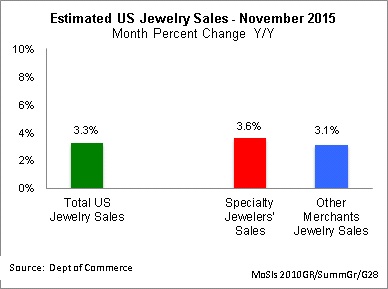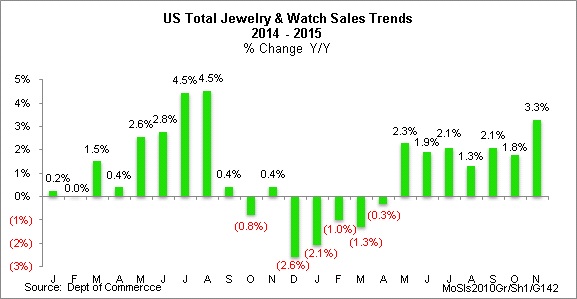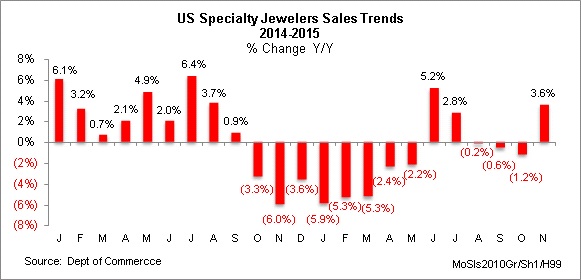US Jewelry Sales Rise in Line With Expectations in November
January 19, 16
Total sales of fine jewelry and fine watches in the US market rose by 3.3 percent in November 2015 when compared to November 2014, according to preliminary data from the US Department of Commerce. That gain is in line with expectations; forecasts called for a low single-digit sales increase for the November-December 2015 Holiday Selling Season.
Further, the government’s jewelry sales data for October was revised downward. This is a continuing trend: preliminary numbers appear to show solid gains, but later revisions show notable weaknesses in consumer demand for jewelry. Preliminary data for October had shown that total US jewelry industry sales were up 2 percent, however, that was revised downward to a smaller 1.8 percent gain. Further, based on preliminary data, specialty jewelers’ October sales dropped by only 0.4 percent, however, this was revised to a 1.2-percent decline.
Based on November’s continued trend of a low single-digit sales gain, we remain comfortable with our forecast of a sales increase in the low single-digit range for the all-important just-completed November-December 2015 period.
Total Jewelry Sales Up in November
Total sales of fine jewelry and fine watches in the US market in November were an estimated $6.3 billion, according to the latest preliminary data from the Department of Commerce.
In contrast to prior months’ sales trends, specialty jewelers posted a solid gain when compared to the overall industry sales increase, as shown in the graph below.

· Specialty jewelers, those merchants who derive a majority of their revenues from the sale of jewelry and watches, posted a sales gain of 3.6 percent in November. Specialty jewelers’ sales represent just over 40 percent of total US jewelry sales.
· Jewelry sales through multi-line merchants such as Wal-Mart, Costco, and others rose by an estimated 3.1 percent during the November. Jewelry sales through multi-line merchants represent a little less than 60 percent of total US jewelry sales.
· Specialty jewelers’ sales tend to be more cyclical than jewelry sales at multi-line merchants. Specialty jewelers’ often rise significantly during the three major sales periods during the year: Valentine’s Day, Mother’s Day, and Christmas, which is partially because shoppers think of jewelry for those three calendar events. In part, it is also because jewelry expenditures at multi-line retailers tend to be impulse purchases: a shopper who is in a Wal-Mart store for food and clothing just happens to pass by the jewelry sales counter and sees something they want. Specialty jewelers cannot compete with that kind of shopper traffic.
Jewelry Demand Positive in November
Based on jewelry demand for the past seven months – a period which reflects American shoppers’ renewed interest in jewelry – sales have grown by an average of 2.1 percent. On a full year-to-date basis, including the first four months of the year when jewelry sales were particularly weak, jewelry sales were up by only 0.9 percent to the end of November 2015.
The graph below illustrates monthly growth since the beginning of 2014, on a year-to-year basis, of fine jewelry and fine watch sales in the US market.

Specialty Jewelers’ Sales Solid
Shoppers think of their favorite specialty jeweler for selected calendar events such as Christmas. As a result, specialty jewelers’ sales rose by a solid 3.6 percent in November, based on preliminary data. It is important to note that the government has consistently revised preliminary sales data downward in subsequent months, so it is highly likely that this number will be lower, when revised data becomes available.
Specialty jewelers’ sales during November were an estimated $2.6 billion, a 3.6 percent increase over November 2014, as the graph below illustrates. This is in line with reports from our sample of specialty jewelers.

Outlook – We Are Optimistic
The US jewelry industry has just completed the all-important November-December period. Based on some early reports, we believe that current sales trends will continue: low single-digit gains.